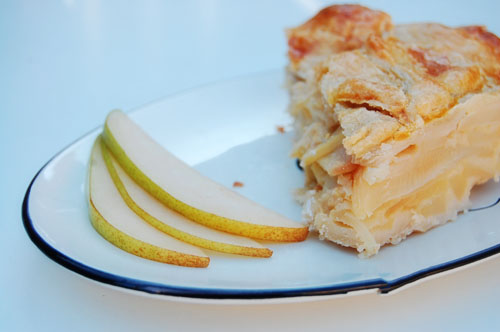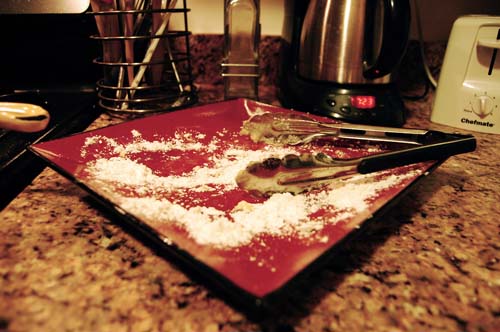Apple & Pear Pie
Now, as someone who was raised in “real” America and currently lives in “fake” America, my take on the American experience is well… very American. Influences from my conservative parents to my left wing art school friends have shaped who I am, and the way that I eat and cook. I’m just as likely to eat a Garden Roll at my favorite sushi place as I am to make grits, which I think makes me a very typical American.
So, in the spirit of a bipartisan, holistic, and unified America, I’m offering you a new twist on an American favorite, the apple and pear pie. This pie is originally based on something I saw on Food Network at some point. I believe it was originally a Giada recipe. Anyway, like most recipes, the first time you make them they belong to the creator. By the fourth or fifth time, you’ve changed and adapted the recipe enough that it’s your own.
This is a pretty malleable recipe, so I shop for and make this pie based on whims. This week at the farmers market there was a wonderful display of apples and pears, so I picked two pears and three apples. What makes this pie so tasty, I think, is the relationship between the pear and apple, as well as the spices. I’ve posted a general pie crust recipe, which you can adapt for this pie by adding nutmeg, cinnamon, ginger, and honey into the crust.
Really, the most important thing to keep in mind while making a pie is pacing. Some elements, like how long the pie crust needs to sit in the fridge or how long the fruit needs to simmer, impact how you go about making the pie. It’s also important to adjust the recipe for your circumstances. This is the first time I’ve made a closed-top pie since I moved to our new apartment, and the top was brown within 45 minutes. Which means that I’m going to need to readjust temperature and time to fit my apartment.
This pie is so perfectly balanced in texture, flavor, and weight, you’ll want to make it a staple in your American experience. My suggestion? Out with the old, in with the new! With a government overhaul and the promise (hope, no matter how naive it may be) of change, let’s adapt to fit.
The New American Pie
1 lemon
3 apples
3 pears
2/3 cup sugar
1/2 tsp cinnamon
1/2 tsp ginger
1/4 tsp salt
Pinch of nutmeg
1/4 cup of butter
1/4 cup all p flour
1/2 tsp vanilla
1 egg
4 tbsp honey (2 for the filling and 2 for the topping)
Pie crust (find recipe here)
Start your pie crust, since it will need to sit in the fridge. For this recipe, you want to add nutmeg, cinnamon, ginger, and honey to your crust.
Peel, core, and slice the fruit. Your chunks should be 1/2 inch or smaller. Squeeze lemon juice over the fruit, then toss in sugar, salt, and spices. In a large skillet or deep dish, melt the butter. You’re going to cook the fruit until it’s tender, so you want your temperature to be low to medium. Add fruit and cook until juices simmer and fruit softens. You don’t want the juices to evaporate out. If they do, your pie will have a dry filling. So, watch it closely. When the fruit is tender, mix flour in. Add vanilla and honey, and remove from heat. Cool completely.
Roll out bottom crust and place in pie dish. Pour in filling. Roll out top crust and press on gently, pinching bottom and top together to create a seal. Cut slits in the top. Whisk together honey, egg, and sugar. Brush onto the top.
Bake at 425* for 15 minutes, and then 50 minutes at 325*


















